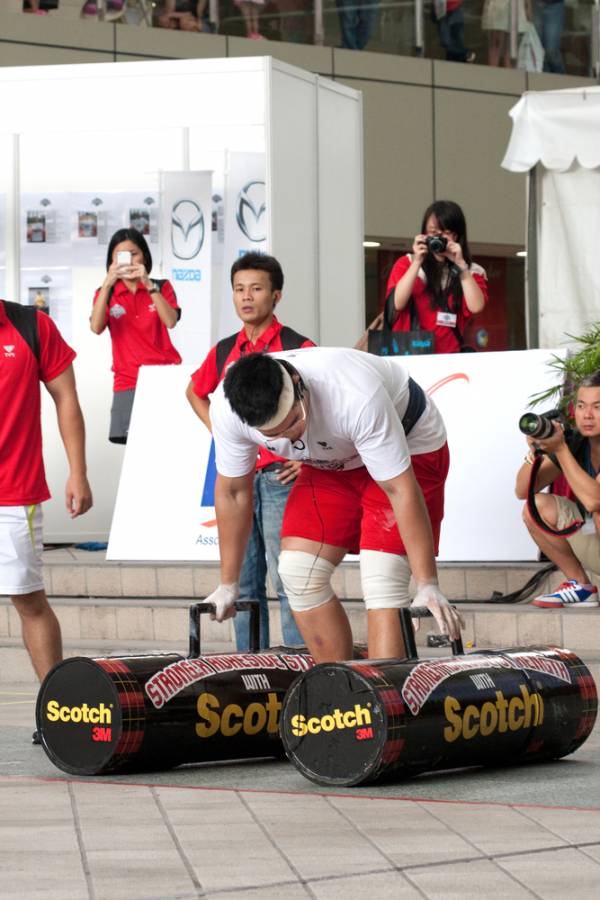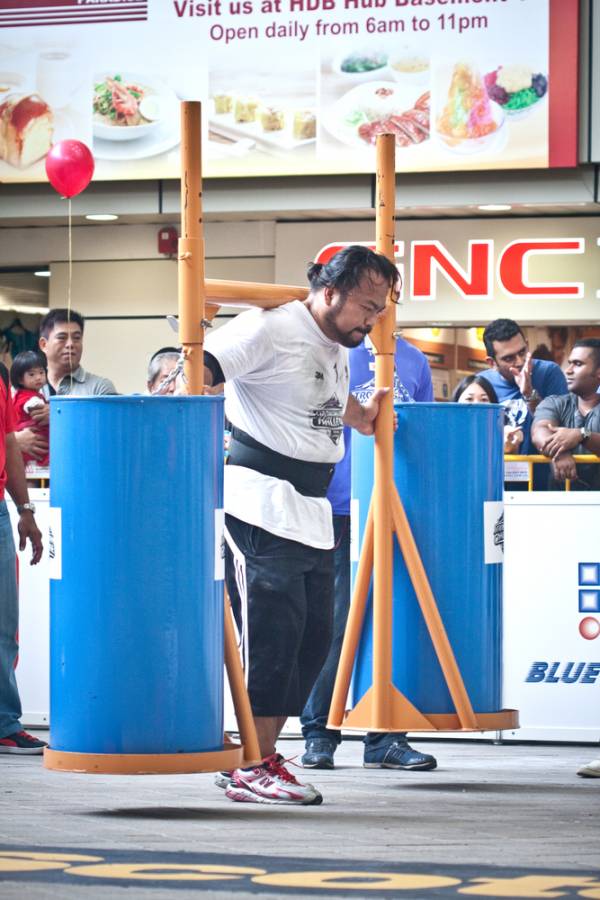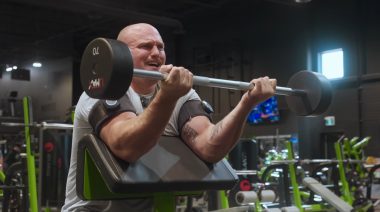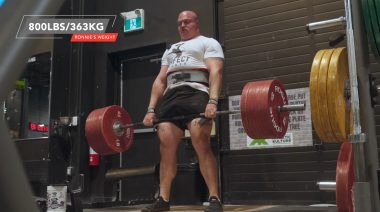Click Here to Try Our Free Strongman Workouts
Strongman-strong is a special kind of strong. These guys (and girls) are expected and able to display their strength across all manner of odd movements and odder objects. In addition, strongman requires strength in multiple aspects ranging from static strength, to max strength, and across multiple heavy reps too. Strongman events are not limited to two or three unchanging lifts as in weightlifting and powerlifting, respectively. There are usually half-a-dozen or so events at a strongman meet. And each meet is different – different events, different equipment, different weights, and different challenges.
Want to know how they build this kind of all-encompassing strength? We can learn a lot from taking a look at the basic principles of strongman training. Whether you aim to be a strongman or simply a strong man, the principles are the same.
Here are five elements of strongman training that can teach us a great deal about getting truly strong:
1. Strict Overhead Work
The strict overhead press is a dying art. Powerlifters naturally concentrate on the bench press, and weightlifters train the push press, if they train a press at all. However, it’s no coincidence that some of the best strongmen in the world include strict overhead work in their training.
The strict press is a lift where there is nowhere to hide. There is no masking a lack of strength in this area with strength from another. It is a raw lift and a fantastic strength builder. You need core strength, and to know how to use it. You need power through the ground, and to know how to create it. You may well be able to jerk heavy but when you are holding a rock, log, or any other awkward object at chest height and having to lean back, I’ll be damned if you can make a decent jerk out of it.
The moral of the story is that if you want to get seriously strong shoulders, strong enough to cope with whatever is thrown onto them, you need to strict press.
The strict shoulder press builds a foundation for other types of overhead work.
2. Squat for Reps
Squatting heavy for numerous reps is a stern test of guts and balls mental and physical fortitude. Those who have done the Smolov squat routine will know that even four heavy sets of nine reps isn’t easy. Some of you will have done the occasional set of 20 rep squats. If you’ve done these honestly (i.e with your 10-rep max), the mere thought of them is enough to induce mild trembling and sweaty palms.
The mental aspect of high rep squats is up there with the hardest conditioning workouts. Hell, it is conditioning. There’s something about having a heavy bar pressing hard on your back, and having to take yourself down to the bottom of a squat time and again knowing that you may well stay down there. It takes a special kind of courage, and one that pays off.
There’s no doubt high rep squats are highly effective when done frequently. This boils down to one of the fundamentals of strongman-based strength. It’s not good enough for a strongman to be strong for one, two, or just a few reps. They, and you, need to be able to hit squats for reps.
The benefits of being able to do so work both ways. Increasing limit strength definitely impacts the amount you can lift for multiple reps. Yet the reverse is true after hitting 10 to 12 reps in 60 seconds at a ridiculous percentage of your max, hitting a heavy double with all the time in the world to do it in suddenly doesn’t seem so bad.
Squatting for reps builds strength to take on the world. You can quote me on that.
3. Deadlift
 Deadlifts seem to have a mixed reception within the strength world. Some feel that you don’t need to do them, that other lifts will cover that base. Others feel that deadlifts are too valuable not to include. Strongman makes no excuses about this one – you need to deadlift, often, and with variety.
Deadlifts seem to have a mixed reception within the strength world. Some feel that you don’t need to do them, that other lifts will cover that base. Others feel that deadlifts are too valuable not to include. Strongman makes no excuses about this one – you need to deadlift, often, and with variety.
It’s easy to see why strongmen include deadlifts. They encounter deadlifts in many different forms – max lifts, max reps, axles, and all at different heights. It would be criminal not to pull on a regular basis in preparation. The benefits of pulling big weights are numerous and BIG – hip strength, posterior chain strength, and, of course, grip strength are three massive reasons to train the deadlift regularly.
The inevitable further questions arise – conventional or sumo? Touch-and-go or drop the bar? Barbell or trap bar? Heavy or deadlift for reps? My answer – all of the above. Mix it up. My supremely valuable additional insight – it depends!
We’re going to need a whole other article for this, but for now I would say conventional (more strength carryover), drop the bar (build starting strength), barbell (classic), and both heavy and for reps (necessary). Would you like to see an article on deadlift considerations and variations? Let me know in the comments.
The bottom line is – it pays to deadlift.
 4. Weighted Carries
4. Weighted Carries
The mere principle of having a weight on your back that is more than you squat, or a weight in your hands that is more than you deadlift, will fire up your CNS, build connective tissue, and simply get your body used to carrying a heavy weight for a prolonged period of time. Do you think this will play back into your lifts? I assure you that it will.
Weighted carries are an on-the-job lesson for your core, your breathing, and learning how to brace the spine. In fact, weighted carries are an unparalleled lesson in learning how to move your limbs whilst bracing the spine – and that is perhaps the most fundamental and important lesson of strength training ever.
5. Prowler and Sled Work
I’m probably going to offend a few people here, but strongman work is some of the hardest, most humbling physical work you can do. Many times I have witnessed people who are physically fit getting abused and humbled by moving heavy weights over long distances quickly.
Sled or prowler pushes and pulls are the epitome of that concept. Ever heard of prowler flu? There is nothing that feels quite the same as pushing or pulling a heavy sled over long distances, multiple times. Okay, perhaps hill sprints are close. Carrying, pulling, or even pushing heavy stuff up a hill is even more lethal.
Strongmen need to recover quickly between taxing events. Fast and furious prowler and sled work is quick to recover from in itself, allowing you to build phenomenal work capacity.
Prowler and sled work is supremely effective gross-level conditioning for strength athletes. I will even go so far as say that even if you don’t do anything else from this article – do this.
If you want strength that is pervasive, persuasive, and permanent, you need to build rock solid foundations. Make smart, but simple, choices. We always hear that we shouldn’t train exactly like the top guys in the world at any sport, that their training isn’t for mere mortals. That’s true, but we are not copying a program here, we are taking principles of strength and applying them.
And applying them is the key. As with anything, put all this through your personal filter. Try it, apply it and see for yourself. And make sure to come back and let me know how it goes!
Click Here to Try Our Free Strongman Workouts
Photos courtesy of Shutterstock.






